Biochemical Basis of Altitude Adaptation and Antioxidant System Activity during Autumn Leaf Senescence in Beech Populations
Abstract
1. Introduction
2. Materials and Methods
2.1. Plant Material and Experimental Design
2.2. Biochemical Analysis
2.2.1. Chlorophyll and Carotenoid Analysis
2.2.2. Soluble Protein Analysis
2.2.3. Oxidative Stress Marker Determination
2.2.4. Ascorbate and Dehydroascorbate Content Determination
2.2.5. Antioxidative Enzyme Activity Determination
2.3. Data Analysis
3. Results
3.1. Temperature Conditions during the Sampling Periods
3.2. Chlorophyll and Protein Contents
3.3. Oxidative Stress Markers
3.4. Low-Molecular-Weight Antioxidants
3.5. Antioxidative Enzyme Activity
3.6. Correlation and PCA Analysis
4. Discussion
5. Conclusions
Supplementary Materials
Author Contributions
Funding
Data Availability Statement
Conflicts of Interest
References
- Dolnicki, A.; Kraj, W. Leaf morphology and the dynamics of frost-hardiness of shoots in two phenological forms of European beech (Fagus sylvatica L.) from Southern Poland. Electron. J. Pol. Agric. Univ. 2001, 4, 1. [Google Scholar]
- Kempf, M.; Banach, J.; Skrzyszewska, K. Morphological variability of beech leaves from early and late flushing provenances. Balt. For. 2018, 24, 210–217. [Google Scholar]
- Kraj, W. Antioxidative enzyme activity as the factor causing differential autumn senescence in phenological forms of beech (Fagus sylvatica L.). Acta Physiol. Plant. 2017, 39, 16. [Google Scholar] [CrossRef]
- Kraj, W. Stem girdling affects the carbon/nitrogen imbalance and oxidative stress, and induces leaf senescence in phenological forms of beech (Fagus sylvatica). Acta Biol. Cracov. Bot. 2017, 59, 67–79. [Google Scholar] [CrossRef]
- Kraj, W. Chlorophyll degradation and the activity of chlorophyllase and Mg-dechelatase during leaf senescence in Fagus sylvatica. Dendrobiology 2015, 74, 43–57. [Google Scholar] [CrossRef]
- Kraj, W. Proteolytic activity and nitrogen remobilisation in senescing leaves of phenological forms of Fagus sylvatica. Dendrobiology 2014, 72, 163–176. [Google Scholar] [CrossRef]
- Kraj, W.; Sztorc, A. Genetic structure and variability of phenological forms in the European beech (Fagus sylvatica L.). Ann. For. Sci. 2009, 66, 203. [Google Scholar] [CrossRef]
- Müller, M.; Finkeldey, R. Genetic and adaptive trait variation in seedlings of European beech provenances from Northern Germany. Silvae Genet. 2016, 65, 65–73. [Google Scholar] [CrossRef]
- Ciocîrlan, E.; Sofletea, N.; Ducci, F.; Curtu, A.L. Patterns of genetic diversity in european beech (Fagus sylvatica L.) at the eastern margins of its distribution range. IForest 2017, 10, 916–922. [Google Scholar] [CrossRef]
- Szasz-Len, A.M.; Konnert, M. Genetic diversity in European beech (Fagus sylvatica L.) seed stands in the Romanian carpathians. Ann. For. Res. 2018, 61, 65–80. [Google Scholar] [CrossRef]
- Thiel, D.; Kreyling, J.; Backhaus, S.; Beierkuhnlein, C.; Buhk, C.; Egen, K.; Huber, G.; Konnert, M.; Nagy, L.; Jentsch, A. Different reactions of central and marginal provenances of fagus sylvatica to experimental drought. Eur. J. For. Res. 2014, 133, 247–260. [Google Scholar] [CrossRef]
- Harter, D.E.V.; Nagy, L.; Backhaus, S.; Beierkuhnlein, C.; Fussi, B.; Huber, G.; Jentsch, A.; Konnert, M.; Thiel, D.; Kreyling, J. A comparison of genetic diversity and phenotypic plasticity among european beech (Fagus sylvatica L.) populations from Bulgaria and Germany under drought and temperature manipulation. Int. J. Plant Sci. 2015, 176, 232–244. [Google Scholar] [CrossRef]
- García-Plazaola, J.I.; Esteban, R.; Hormaetxe, K.; Fernández-Marín, B.; Becerril, J.M. Photoprotective responses of Mediterranean and Atlantic trees to the extreme heat-wave of summer 2003 in Southwestern Europe. Trees 2008, 22, 385–392. [Google Scholar] [CrossRef]
- Vitasse, Y.; Hoch, G.; Randin, C.F.; Lenz, A.; Kollas, C.; Scheepens, J.F.; Körner, C. Elevational adaptation and plasticity in seedling phenology of temperate deciduous tree species. Oecologia 2013, 171, 663–678. [Google Scholar] [CrossRef]
- Lim, P.O.; Kim, H.J.; Gil Nam, H. Leaf senescence. Annu. Rev. Plant Biol. 2007, 58, 115–136. [Google Scholar] [CrossRef]
- Buchanan-Wollaston, V.; Earl, S.; Harrison, E.; Mathas, E.; Navabpour, S.; Page, T.; Pink, D. The molecular analysis of leaf senescence-a genomics approach. Plant Biotechnol. J. 2003, 1, 3–22. [Google Scholar] [CrossRef] [PubMed]
- García-Plazaola, J.I.; Hernández, A.; Becerril, J.M. Antioxidant and pigment composition during autumnal leaf senescence in woody deciduous species differing in their ecological traits. Plant Biol. 2003, 5, 557–566. [Google Scholar] [CrossRef]
- Coleman, G.D.; Englert, J.M.; Chen, T.H.H.; Fuchigami, L.H. Physiological and environmental requirements for poplar (Populus deltoides) bark storage protein degradation. Plant Physiol. 1993, 102, 53. [Google Scholar] [CrossRef] [PubMed]
- Kraj, W. Reactive oxygen species and antioxidant levels as the factors of autumn senescence in phenological forms of beech (Fagus sylvatica L.). Acta Physiol. Plant 2016, 38, 1–12. [Google Scholar] [CrossRef]
- Procházková, D.; Wilhelmová, N. Leaf senescence and activities of the antioxidant enzymes. Biol. Plant 2007, 51, 401–406. [Google Scholar] [CrossRef]
- Juvany, M.; Müller, M.; Munné-Bosch, S. Photo-oxidative stress in emerging and senescing leaves: A mirror image. J. Exp. Bot. 2013, 64, 3087–3098. [Google Scholar] [CrossRef]
- Jajic, I.; Sarna, T.; Strzałka, K. Senescence, stress, and reactive oxygen species. Plants 2015, 4, 393–411. [Google Scholar] [CrossRef] [PubMed]
- Choudhury, S.; Panda, P.; Sahoo, L.; Panda, S.K. Reactive oxygen species signaling in plants under abiotic stress. Plant Signal. Behav. 2013, 8, e236811–e236816. [Google Scholar] [CrossRef] [PubMed]
- Hossain, M.A.; Bhattacharjee, S.; Armin, S.M.; Qian, P.; Xin, W.; Li, H.Y.; Burritt, D.J.; Fujita, M.; Tran, L.S.P. Hydrogen peroxide priming modulates abiotic oxidative stress tolerance: Insights from ROS detoxification and scavenging. Front. Plant Sci. 2015, 6. [Google Scholar] [CrossRef] [PubMed]
- Zimmermann, P.; Zentgraf, U. The correlation between oxidative stress and leaf senescence during plant development. Cell Mol. Biol. Lett. 2005, 10, 515–534. [Google Scholar]
- Kumar, V.; Khare, T.; Srivastav, A.; Surekha, C.; Shriram, V.; Wani, S.H. Oxidative Stress and Leaf Senescence: Important Insights, in Senescence Signalling and Control in Plants; Sarwat, M., Tuteja, N., Eds.; Academic Press: Cambridge, MA, USA, 2019; pp. 139–163. [Google Scholar]
- Schuster, C.; Kirchner, M.; Jakobi, G.; Menzel, A. Frequency of inversions affects senescence phenology of Acer pseudoplatanus and Fagus sylvatica. Int. J. Biometeorol. 2014, 58, 485–498. [Google Scholar] [CrossRef]
- Fracheboud, Y.; Luquez, V.; Björkén, L.; Sjödin, A.; Tuominen, H.; Jansson, S. The control of autumn senescence in European aspen. Plant Physiol. 2009, 149, 1982–1991. [Google Scholar] [CrossRef]
- Kreyling, J.; Thiel, D.; Nagy, L.; Jentsch, A.; Huber, G.; Konnert, M.; Beierkuhnlein, C. Late frost sensitivity of juvenile Fagus sylvatica L. differs between southern Germany and Bulgaria and depends on preceding air temperature. Eur. J. For. Res. 2012, 131, 717–725. [Google Scholar] [CrossRef]
- Kreyling, J.; Buhk, C.; Backhaus, S.; Hallinger, M.; Huber, G.; Huber, L.; Jentsch, A.; Konnert, M.; Thiel, D.; Wilmking, M.; et al. Local adaptations to frost in marginal and central populations of the dominant forest tree Fagus sylvatica L. as affected by temperature and extreme drought in common garden experiments. Ecol. Evol. 2014, 4, 594–605. [Google Scholar] [CrossRef]
- Pigliucci, M.; Murren, C.J.; Schlichting, C.D. Phenotypic plasticity and evolution by genetic assimilation. J. Exp. Biol. 2006, 209, 2362. [Google Scholar] [CrossRef]
- Vitasse, Y.; Delzon, S.; Bresson, C.C.; Michalet, R.; Kremer, A. Altitudinal differentiation in growth and phenology among populations of temperate-zone tree species growing in a common garden. Can. J. For. Res. 2009, 39, 1259–1269. [Google Scholar] [CrossRef]
- Lichtenthaler, H.K.; Wellburn, A.R. Determinations of total carotenoids and chlorophylls a and b of leaf extracts in different solvents. Biochem. Soc. Trans. 1983, 11, 591–592. [Google Scholar] [CrossRef]
- Bradford, M.M. A rapid and sensitive method for the quantitation of microgram quantities of protein utilizing the principle of protein-dye binding. Anal. Biochem. 1976, 72, 248–254. [Google Scholar] [CrossRef]
- Tan, A.S.; Berridge, M.V. Superoxide produced by activated neutrophils efficiently reduces the tetrazolium salt, WST-1 to produce a soluble formazan: A simple colorimetric assay for measuring respiratory burst activation and for screening anti-inflammatory agents. J. Immunol. Methods 2000, 238, 59–68. [Google Scholar] [CrossRef]
- Dhindsa, R.S.; Plumb-Dhindsa, P.; Thorpe, T.A. Leaf senescence: Correlated with increased levels of membrane permeability and lipid peroxidation, and decreased levels of superoxide dismutase and catalase. J. Exp. Bot. 1981, 32, 93–101. [Google Scholar] [CrossRef]
- Gillespie, K.M.; Ainsworth, E.A. Measurement of reduced, oxidized and total ascorbate content in plants. Nat. Protoc. 2007, 2, 871. [Google Scholar] [CrossRef]
- Aebi, H. Isolation, purification, characterization, and assay of antioxygenic enzymes: Catalase in vitro. Methods Enzymol. 1984, 105, 121–126. [Google Scholar] [PubMed]
- Murshed, R.; Lopez-Lauri, F.; Sallanon, H. Microplate quantification of enzymes of the plant ascorbate–glutathione cycle. Anal. Biochem. 2008, 383, 320–322. [Google Scholar] [CrossRef] [PubMed]
- Peskin, A.V.; Winterbourn, C.C. A microtiter plate assay for superoxide dismutase using a water-soluble tetrazolium salt (WST-1). Clin. Chim. Acta 2000, 293, 157–166. [Google Scholar] [CrossRef]
- Sokal, R.R.; Rohlf, F.J. Biometry: The Principles and Practice of Statistics in Biological Research. A Series of books in Biology; W. H. Freeman and Company: New York, NY, USA, 1995; p. 887. [Google Scholar]
- Vitasse, Y.; Porté, A.J.; Kremer, A.; Michalet, R.; Delzon, S. Responses of canopy duration to temperature changes in four temperate tree species: Relative contributions of spring and autumn leaf phenology. Oecologia 2009, 161, 187–198. [Google Scholar] [CrossRef] [PubMed]
- Mostofa, M.G.; Seraj, Z.I.; Fujita, M. Exogenous sodium nitroprusside and glutathione alleviate copper toxicity by reducing copper uptake and oxidative damage in rice (Oryza sativa L.) seedlings. Protoplasma 2014, 251, 1373–1386. [Google Scholar] [CrossRef]
- Rana, P.S.; Saklani, P. Analyzing the effect of altitudinal variation in enzymatic antioxidants of coleus forskohlii from Uttarakhand, India. Plant Cell Biotechnol. Mol. Biol. 2019, 20, 442–450. [Google Scholar]
- Öncel, I.; Yurdakulol, E.; Keleş, Y.; Kurt, L.; Yıldız, A. Role of antioxidant defense system and biochemical adaptation on stress tolerance of high mountain and steppe plants. Acta Oecol. 2004, 26, 211–218. [Google Scholar] [CrossRef]
- Cui, G.; Ji, G.; Liu, S.; Li, B.; Lian, L.; He, W.; Zhang, P. Physiological adaptations of Elymus dahuricus to high altitude on the Qinghai–Tibetan Plateau. Acta Physiol. Plant 2019, 41, 115. [Google Scholar] [CrossRef]
- Munné-Bosch, S.; Jubany-Marí, T.; Alegre, L. Drought-induced senescence is characterized by a loss of antioxidant defences in chloroplasts. Plant Cell Environ. 2001, 24, 1319–1327. [Google Scholar] [CrossRef]
- Čufar, K.; de Luis, M.; Saz, M.A.; Črepinšek, Z.; Kajfež-Bogataj, L. Temporal shifts in leaf phenology of beech (Fagus sylvatica) depend on elevation. Trees Struct. Funct. 2012, 26, 1091–1100. [Google Scholar] [CrossRef]
- Himelblau, E.; Amasino, R.M. Nutrients mobilized from leaves of Arabidopsis thaliana during leaf senescence. J. Plant Physiol. 2001, 158, 1317–1323. [Google Scholar] [CrossRef]
- Guiboileau, A.; Sormani, R.; Meyer, C.; Masclaux-Daubresse, C. Senescence and death of plant organs: Nutrient recycling and developmental regulation. C. R. Biol. 2010, 333, 382–391. [Google Scholar] [CrossRef] [PubMed]
- Delpierre, N.; Dufrêne, E.; Soudani, K.; Ulrich, E.; Cecchini, S.; Boé, J.; François, C. Modelling interannual and spatial variability of leaf senescence for three deciduous tree species in France. Agric. For. Meteorol. 2009, 149, 938–948. [Google Scholar] [CrossRef]
- Distelfeld, A.; Avni, R.; Fischer, A.M. Senescence, nutrient remobilization, and yield in wheat and barley. J. Exp. Bot. 2014, 65, 3783–3798. [Google Scholar] [CrossRef] [PubMed]
- Keskitalo, J.; Bergquist, G.; Gardeström, P.; Jansson, S. A cellular timetable of autumn senescence. Plant Physiol. 2005, 139, 1635–1648. [Google Scholar] [CrossRef] [PubMed]
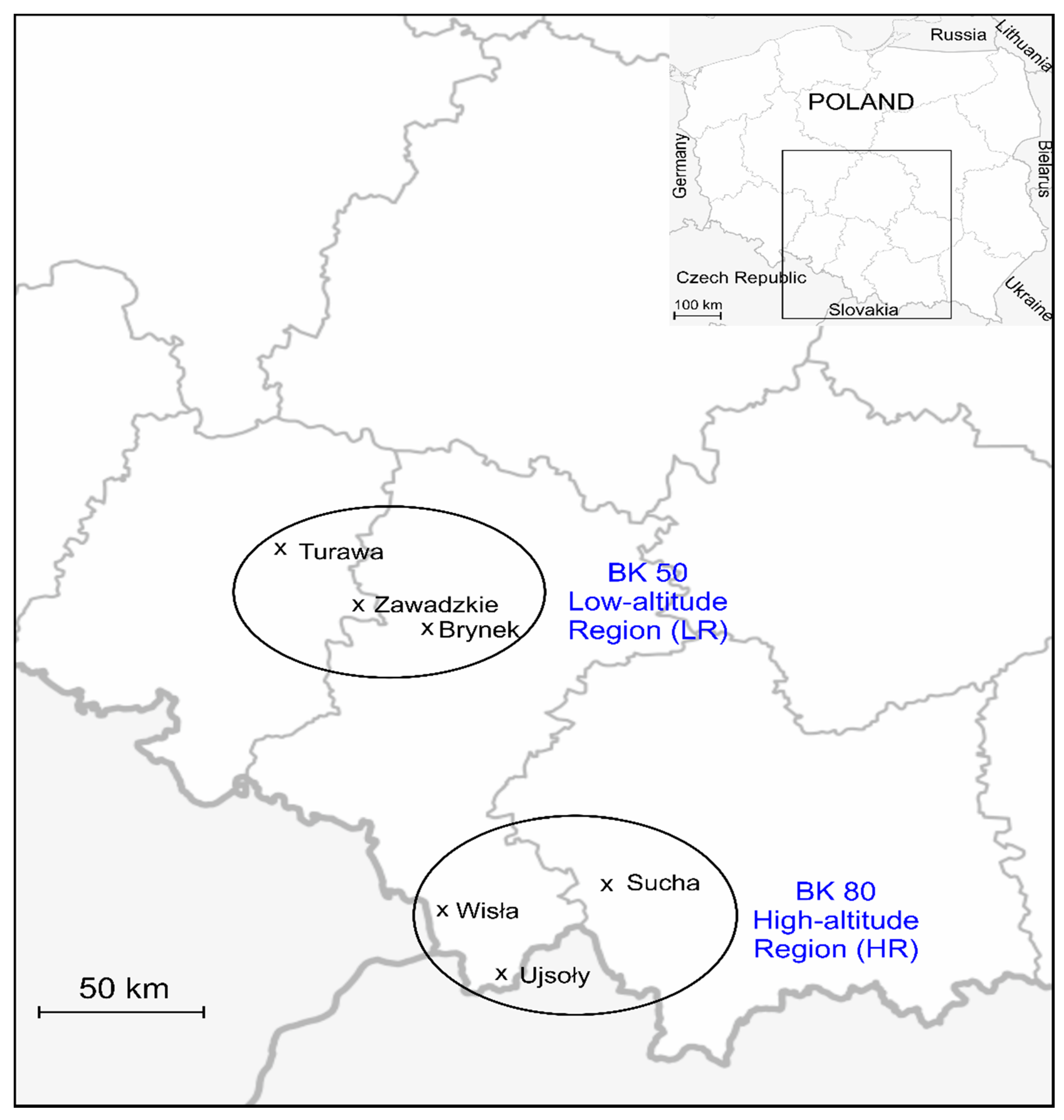

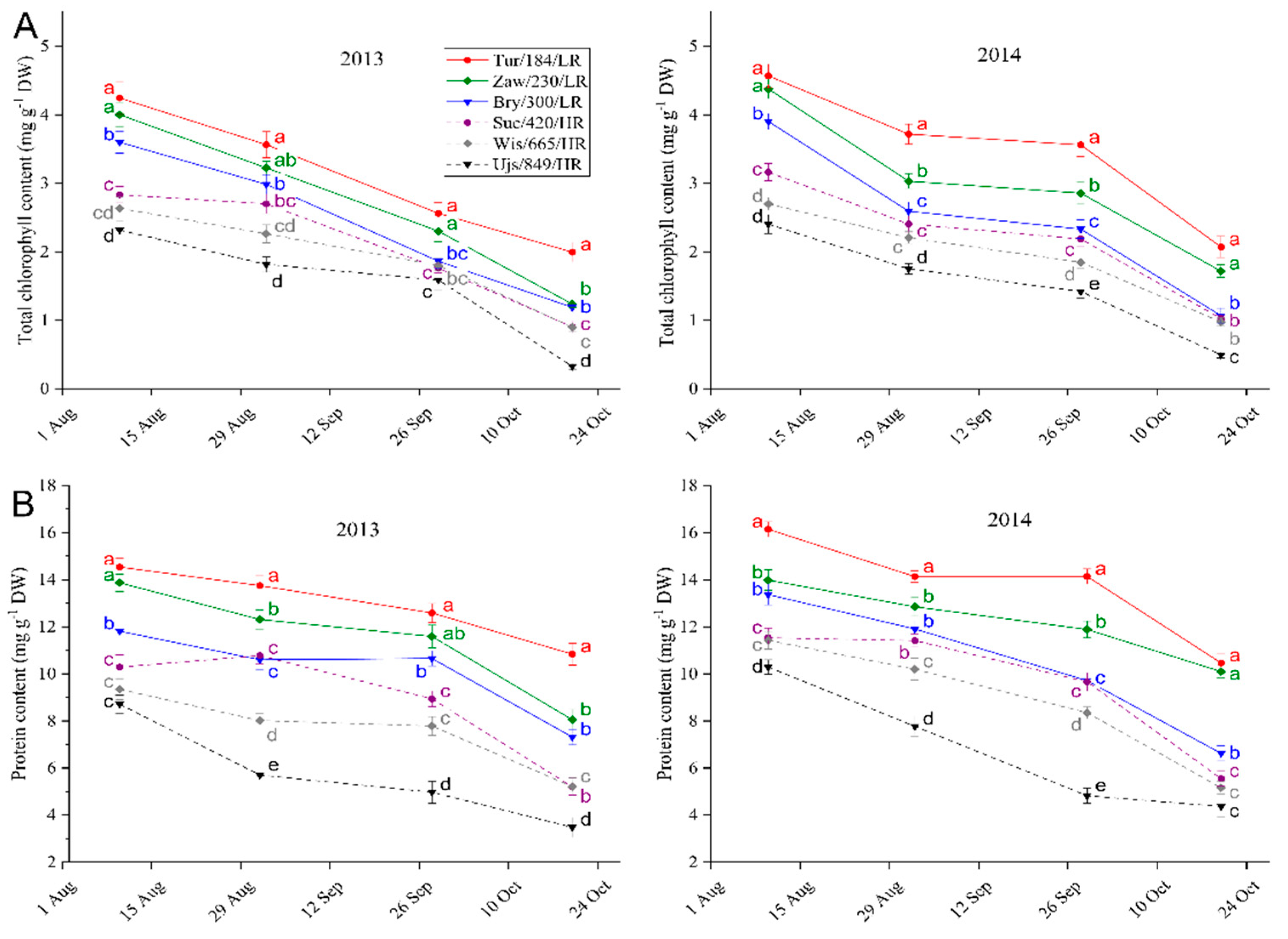

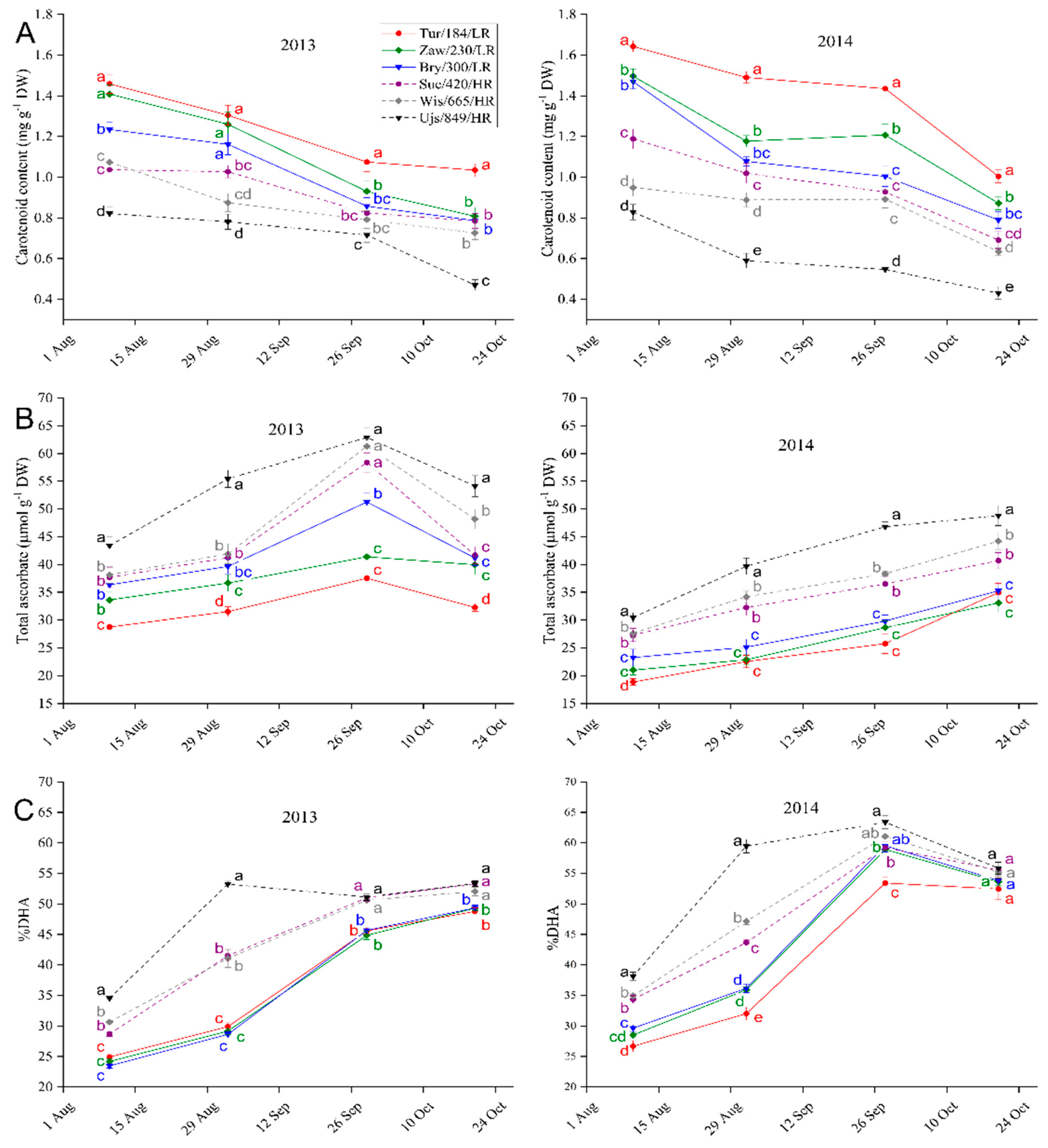
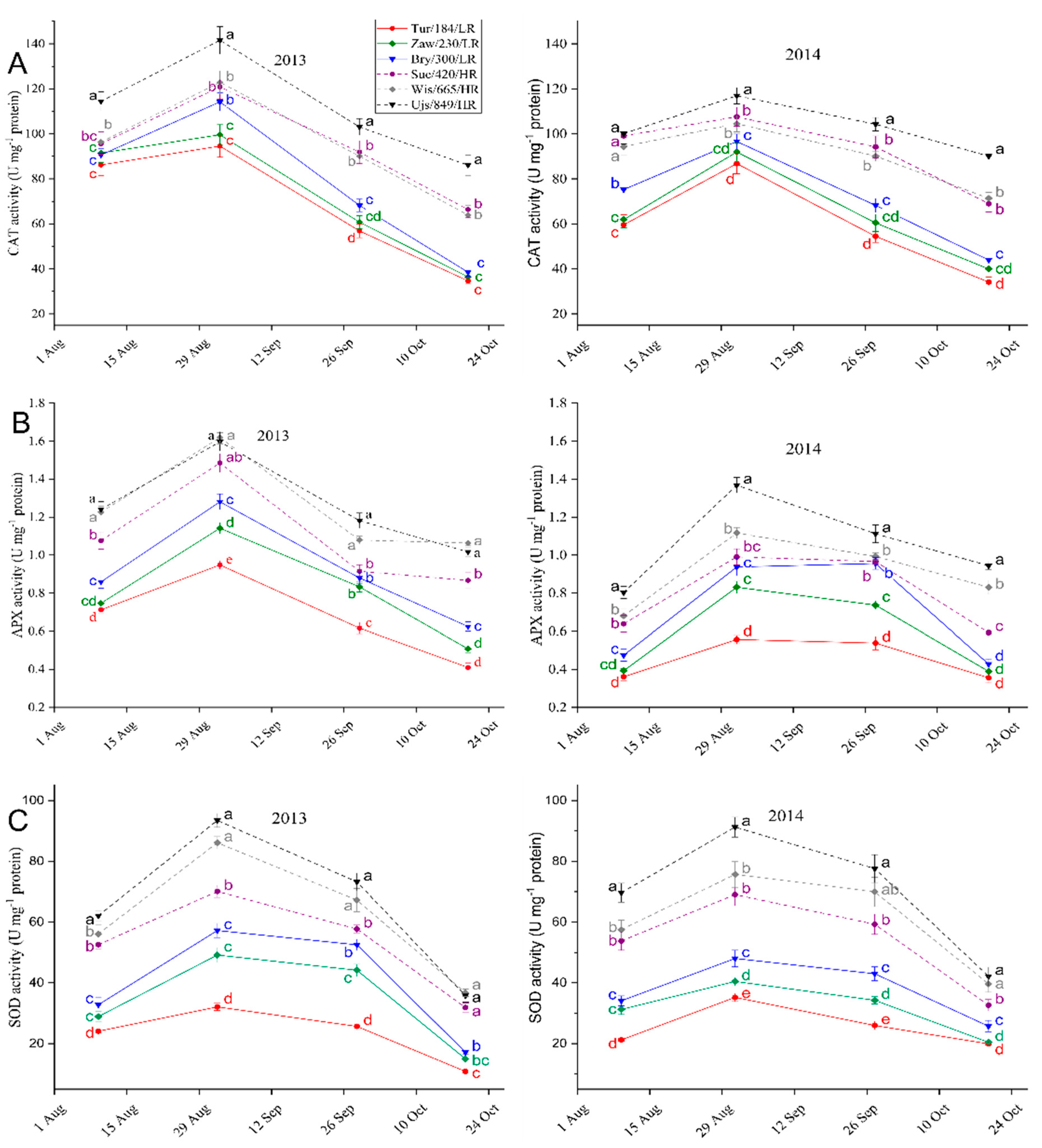
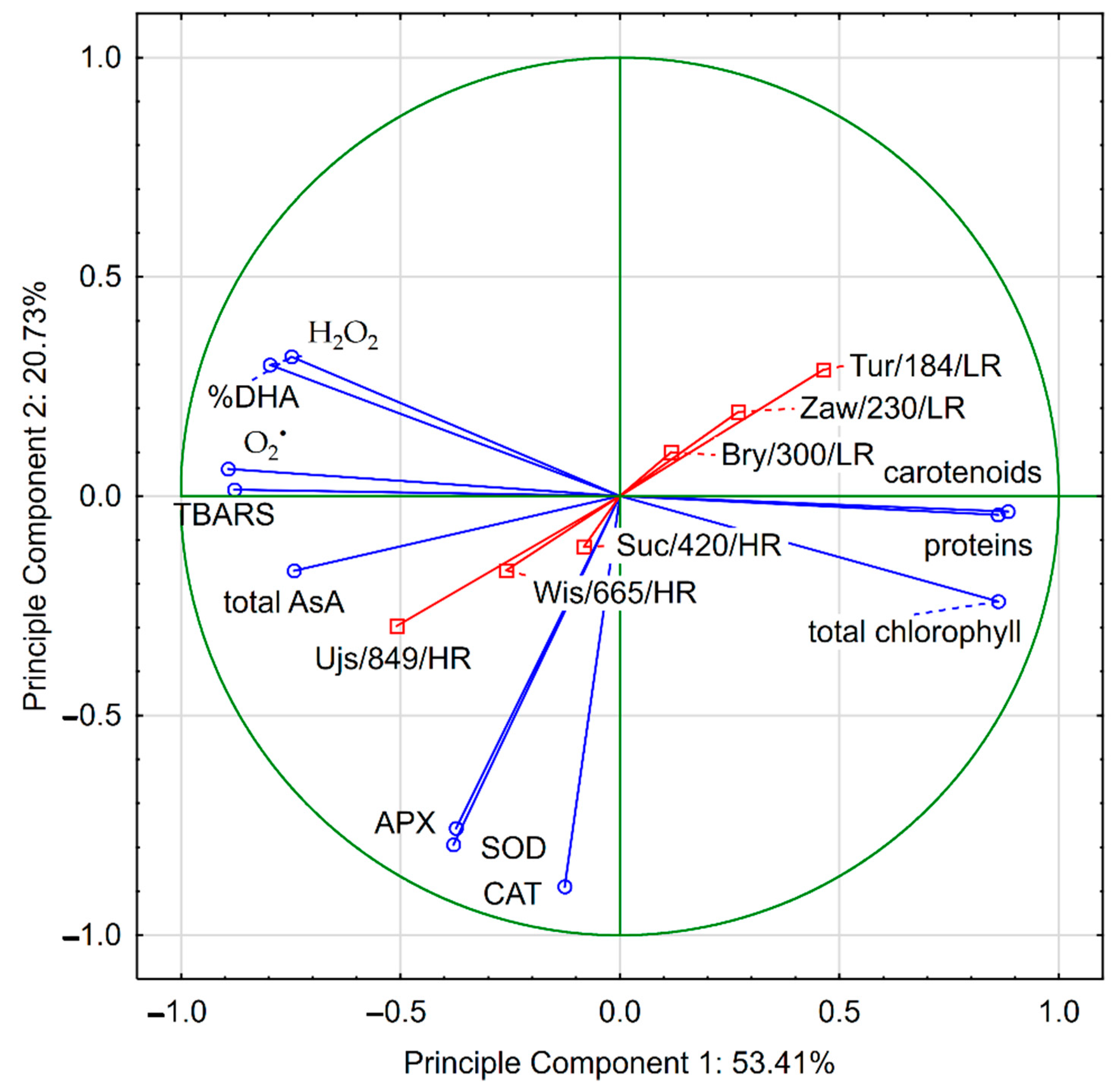
| Provenance Location | Provenance Code (Provenance/Altitude/Region) | Coordinates | Altitude (m) | Total Annual Precipitation (mm) | Annual Minimum Temperature (°C) | Annual Maximum Temperature (°C) | Average Annual Temperature (°C) | Growing Season Length (days) |
|---|---|---|---|---|---|---|---|---|
| Low-altitude region (LR) | ||||||||
| Turawa | Tur/184/LR | 50°44′ N, 18°06′ E | 184 | 700 | −8 | 28 | 9 | 218 |
| Zawadzkie | Zaw/230/LR | 50°36′ N, 18°29′ E | 230 | 700 | −9 | 26 | 9 | 212 |
| Brynek | Bry/300/LR | 50°31′ N, 18°44′ E | 300 | 750 | −8 | 27 | 9 | 224 |
| Regional average | 238 | 717 | −8.3 | 27 | 9 | 218 | ||
| High-altitude region (HR) | ||||||||
| Sucha | Suc/420/HR | 49°44′ N, 19°35′ E | 420 | 1000 | −11 | 24 | 7 | 193 |
| Wisła | Wis/665/HR | 49°39′ N, 18°51′ E | 665 | 1150 | −12 | 22 | 6 | 153 |
| Ujsoły | Ujs/849/HR | 49°28′ N, 19°08′ E | 849 | 1200 | −13 | 23 | 6 | 150 |
| Regional average | 645 | 1117 | −12 | 22 | 6.3 | 165 | ||
| Sampling Periods | Year | |||||||
|---|---|---|---|---|---|---|---|---|
| 2013 | 2014 | |||||||
| Temperature Characteristics (°C) | ||||||||
| Average | Minimum | Maximum | Change | Average | Minimum | Maximum | Change | |
| Phase 0 (two weeks before phase I) | 23.9 | 18.1 | 27.7 | −5.3 | 22.1 | 20.4 | 24.3 | 0.4 |
| Phase I | 17.4 | 13.8 | 23.4 | −4.3 | 16.8 | 12.3 | 23.2 | −5.7 |
| Phase II | 12.8 | 6.5 | 17.0 | −7.3 | 15.6 | 8.6 | 19.8 | −6.6 |
| Phase III | 9.3 | 3.6 | 14.9 | 3.8 | 13.0 | 7.8 | 16.3 | 2.9 |
| Total sampling period | 15.1 | 3.6 | 27.7 | −13.1 | 16.3 | 7.8 | 24.3 | −9.0 |
| Biochemical Parameter Type | Biochemical Parameter | Provenance Altitude |
|---|---|---|
| Senescence markers | Total chlorophyll | −0.549 |
| Soluble protein | −0.701 | |
| Oxidative stress markers | Hydrogen peroxide (H2O2) | 0.374 |
| Superoxide anion (O2−) | 0.612 | |
| Thiobarbituric acid-reactive substances (TBARS) | 0.614 | |
| Antioxidative components | Total ascorbate | 0.481 |
| % Dehydroascorbate (DHA) | 0.342 | |
| Carotenoids | −0.604 | |
| Antioxidative enzymes | Catalase (CAT) | 0.505 |
| Ascorbate peroxidase (APX) | 0.504 | |
| Superoxide dismutase (SOD) | 0.702 |
Publisher’s Note: MDPI stays neutral with regard to jurisdictional claims in published maps and institutional affiliations. |
© 2021 by the authors. Licensee MDPI, Basel, Switzerland. This article is an open access article distributed under the terms and conditions of the Creative Commons Attribution (CC BY) license (https://creativecommons.org/licenses/by/4.0/).
Share and Cite
Kraj, W.; Zarek, M. Biochemical Basis of Altitude Adaptation and Antioxidant System Activity during Autumn Leaf Senescence in Beech Populations. Forests 2021, 12, 529. https://doi.org/10.3390/f12050529
Kraj W, Zarek M. Biochemical Basis of Altitude Adaptation and Antioxidant System Activity during Autumn Leaf Senescence in Beech Populations. Forests. 2021; 12(5):529. https://doi.org/10.3390/f12050529
Chicago/Turabian StyleKraj, Wojciech, and Marcin Zarek. 2021. "Biochemical Basis of Altitude Adaptation and Antioxidant System Activity during Autumn Leaf Senescence in Beech Populations" Forests 12, no. 5: 529. https://doi.org/10.3390/f12050529
APA StyleKraj, W., & Zarek, M. (2021). Biochemical Basis of Altitude Adaptation and Antioxidant System Activity during Autumn Leaf Senescence in Beech Populations. Forests, 12(5), 529. https://doi.org/10.3390/f12050529





